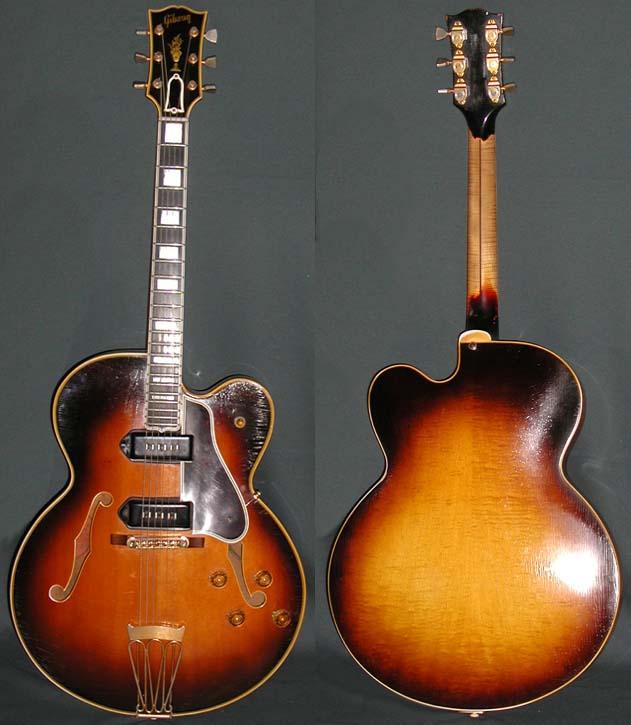This guitar evolved into an electric instrument with a body that was 3 3/8th inches deep and a Venetian cutaway.
As the guitarists became more dependent on the electrified sound, they wanted a comfortable instrument to play. There was no need for a wide body depth.
Gibson took a hint from Fender by producing instruments with a much thinner body. The Byrdland was the first of this kind. Ted McCarty, then Gibson's president, solicited feedback from popular Gibson players.
Two guitarists, Billy Byrd and Hank Garland, suggested Gibson should come up with not just a thinner guitar, but a guitar with a shorter scale neck that would allow them to easily play more single note patterns and unusual chord patterns that were difficult to attain on most normal scale guitars. Gibson decided on the L-5 body style and all the accouterments found on the L-5, but made the guitars depth only 2 ¼ inches.
The neck scale was reduced by one inch to a mere 23 ½ inches. I need to tell you a little bit about Billy Byrd and Hank Garland.
Billy Byrd hailed from Nashville and is best known for his work for Ernest Tubb. Mr. Byrd studied the melodic guitar style of guitarists Charlie Christian and Django Reinhardt. He put this style behind the country tunes of Tubb and others to come up with a sort of jazz-style playing that is still popular in Country and Pop music today.
Garland was a student of Billy Byrd. He started playing guitar at age 6 and became one of Nashville’s go-to players. You can hear him on many of Elvis Presley recordings. He also worked with Patsy Cline, Mel Tillis, Marty Robbins, the Everly Brothers and Roy Orbison. The oft-played Country breakdown known as Sugar foot Rag which is attributed to him.
His career, cut short due to an auto accident that left him in a coma from which he never fully recovered. Both men were not just Country players, but respected musicians in the Jazz world as well.
From it’s inception in 1955 the Byrdland came with a Venetian or rounded cutaway.
Between the years 1960 to 1961, the cutaway on the Byrdlands body was changed to a Florentine (sharp) cutaway.
In 1969 the Venetian cutaway returned on the model for one year, before ceasing production.
In 1976 a limited run of twenty 12-string Byrdland guitars were offered.
The Byrdland, reintroduced in 1977 was produced through 1978.
It resurfaced in 1992. The Byrdland is still available today from Gibson at a price of 7400 to 8800 US dollars.
From 1955 to 1959, the Byrdland came with twin P90 pickups. This changed in late 1959 when Gibson introduced PAF Humbuckers. Due to the shorter length, the pickups were placed closer together.
This arrangement altered the sound slightly compared with full scale Gibson instruments when the toggle was in the center position. The Byrdland was a hollow body instrument and came with a solid spruce carved top.
The body is 17” wide and 21” long, the same measurements as the L-5. The guitars back and sides were made of curly maple. The body was bound with white/black/white on the body, and f-holes. The curly maple bound neck was a three-piece laminated style and joined the body at the 14th fret. In 1960, the neck was updated to five-piece laminate.
It bears mentioning the Byrdland not only had a short scale neck, but also a slightly thinner neck than the L-5. The dimension at the nut was 1.6” in width gradually increasing to 1.9” at the heel.
The fretboard was made of ebony with pearl block fret markers. The fretboard came with 22 frets. This was another first for Gibson. The head was capped with black veneer that featured Gibson’s flower pot inlay. The headstock was also bound, as was the truss rod cover.
All of the metallic hardware was gold-plated, which included the Kluson tuners, tune-o-matic bridge, and trapeze tailpiece. Gibson’s wiring was standard, utilizing two volume and two tone controls and a 3-way toggle. The tailpiece was designed in an unusual three loop style with BYRDLAND engraved on its top.
The guitar was originally offered with a Sunburst or a Natural finish.
In 1977 Wine Red, Ebony, and Cherry Sunburst became options.
Interestingly, a lawsuit was brought against Gibson by the Birdland Jazz Club in New York City for trademark infringement. The suit was dismissed when Gibson was able to prove the name was gleaned from combining the surnames of Billy Byrd and Hank Gar(land).
Ted Nugent is perhaps the most obvious Gibson Byrdland endorser. He is well known for using a Byrdland since the start of his career. Gibson has honored him with his own model.



















1 comment:
fantastic research and info.
have you written about any other guitar with the same scale length?
do you know anything about any Byrdland "lawsuit" guitars?
thanks again for this great blog post
Post a Comment